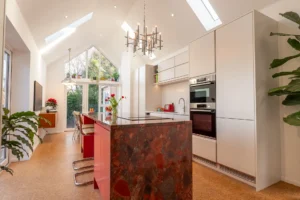 The open-plan kitchen has become a cornerstone of modern family living, offering a multitude of benefits that transcend mere aesthetics. As someone who remembers growing up in a traditional 1980s home with its separate rooms, I can attest to the transformative power of an open-plan kitchen.
The open-plan kitchen has become a cornerstone of modern family living, offering a multitude of benefits that transcend mere aesthetics. As someone who remembers growing up in a traditional 1980s home with its separate rooms, I can attest to the transformative power of an open-plan kitchen.
In those days, we had a reasonably sized kitchen, a separate dining room reserved for special occasions, a meticulously kept front room for guests, and a lounge area with a single television. However, times have changed drastically since then. With the advent of the internet and personal devices, I often wonder if my children would spend their days isolated in their rooms, engrossed in their laptops and iPads, only emerging for sustenance.
 Thankfully, our open-plan kitchen has become a welcoming and inviting communal space that keeps us connected for longer periods of time. It has become the heart of our home, where we gather to share stories, laughter, and create lasting memories.
Thankfully, our open-plan kitchen has become a welcoming and inviting communal space that keeps us connected for longer periods of time. It has become the heart of our home, where we gather to share stories, laughter, and create lasting memories.
Gone are the days of being confined to separate spaces; instead, our open-plan kitchen seamlessly integrates cooking, dining, and living areas, erasing the physical boundaries that once separated them.

This intentional design allows us to engage in different activities while still being close enough to interact and connect as a family.
Whether we’re preparing a delicious meal, assisting with homework, or simply enjoying some downtime in front of the television, the open-plan layout ensures that we are never far from each other’s company.
In today’s fast-paced world, the open-plan kitchen offers more than just a beautiful aesthetic; it acts as a catalyst for strengthening family bonds and fostering a sense of togetherness. It is a space where laughter fills the air, memories are woven, and connections are deepened.




